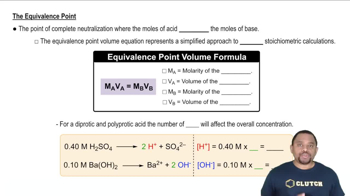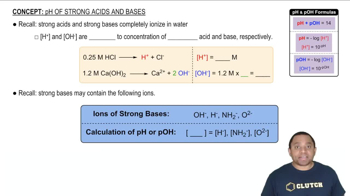Here are the essential concepts you must grasp in order to answer the question correctly.
Titration and Equivalence Point
Titration is a quantitative analytical method used to determine the concentration of a solute in a solution. The equivalence point occurs when the amount of titrant added is stoichiometrically equivalent to the amount of substance being titrated. In this case, it is the point at which the moles of NaOH added completely neutralize the moles of HNO3 present.
Recommended video:
Equivalence Point in Titration
Molarity and Millimoles
Molarity (M) is a measure of concentration defined as the number of moles of solute per liter of solution. Millimoles (mmol) are a smaller unit, where 1 mmol equals 0.001 moles. To find the number of millimoles of HNO3 in the solution, one can multiply the molarity by the volume in liters, allowing for easy calculations in titration problems.
Recommended video:
pH and Acid-Base Neutralization
pH is a measure of the acidity or basicity of a solution, calculated as the negative logarithm of the hydrogen ion concentration. At the equivalence point of a strong acid-strong base titration, the pH is typically around 7 due to the complete neutralization of the acid and base. Understanding how to calculate pH at this point is crucial for interpreting titration results.
Recommended video:
pH of Strong Acids and Bases
 Verified step by step guidance
Verified step by step guidance


